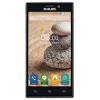Nomi i5050 EVO Z vs Philips Xenium V787
Quelle est la différence entre Nomi i5050 EVO Z et Philips Xenium V787. Découvrez quel smartphone offre les meilleures performances.
Performance (Benchmarks)
| 180 | 3DMark for Android Sling Shot Extreme (OpenGL ES 3.1 / Metal) | 179 |
Caractéristiques
| Nomi i5050 EVO Z | Nom du produit | Philips Xenium V787 |
| Android 7.0 | Système d'exploitation (OS) | Android 5.1 |
| Bluetooth WLAN | Réseaux sans fil | Bluetooth WLAN |
| Yes, microUSB 2.0 | Interfaces / connecteurs | Yes, microUSB 2.0 |
Ecran
| 1920 × 1080 px | Résolution d'écran | 1920 × 1080 px |
| IPS | Type d’écran | IPS LCD |
| Yes | Multipoints (multitouch) capacitif | Yes |
| 5" | Taille écran | 5" |
Processeur (CPU)
| Up to 1.5 GHz quad-core ARM Cortex-A53 | Architecture CPU | Up to 1.3 GHz octa-core ARM Cortex-A53 |
| MT6737T | Processeur | MT6753 |
| Mali-T720 MP2 | GPU | Mali-T720 MP3 |
Mémoire
| 3072 MB | Mémoire RAM | 2048 MB |
| 32 GB | Capacité de stockage (ROM) | 16 GB |
| microSD | Carte mémoire | microSD |
Appareil photo
| Yes, 13 MP | Capteur photo | Yes, 13 MP |
| Yes, 5 MP | Capteur photo avant | Yes, 5 MP |
Communication
| GSM 850 / 900 / 1800 / 1900 | 2G | GSM 850 / 900 / 1800 / 1900 |
| HSDPA 900 / 2100 | 3G | HSDPA 900 / 2100 |
Géolocalisation
| Yes | GPS | Yes |
| Yes | A-GPS | Yes |
Batterie
| 2500 mAh | Capacite de la batterie | 5000 mAh |
Design
| 70.4 / 141.7 / 8.5 mm | Dimensions | 71.6 / 143 / 9.8 mm |
| 142.6 g | Poids | 164 g |

